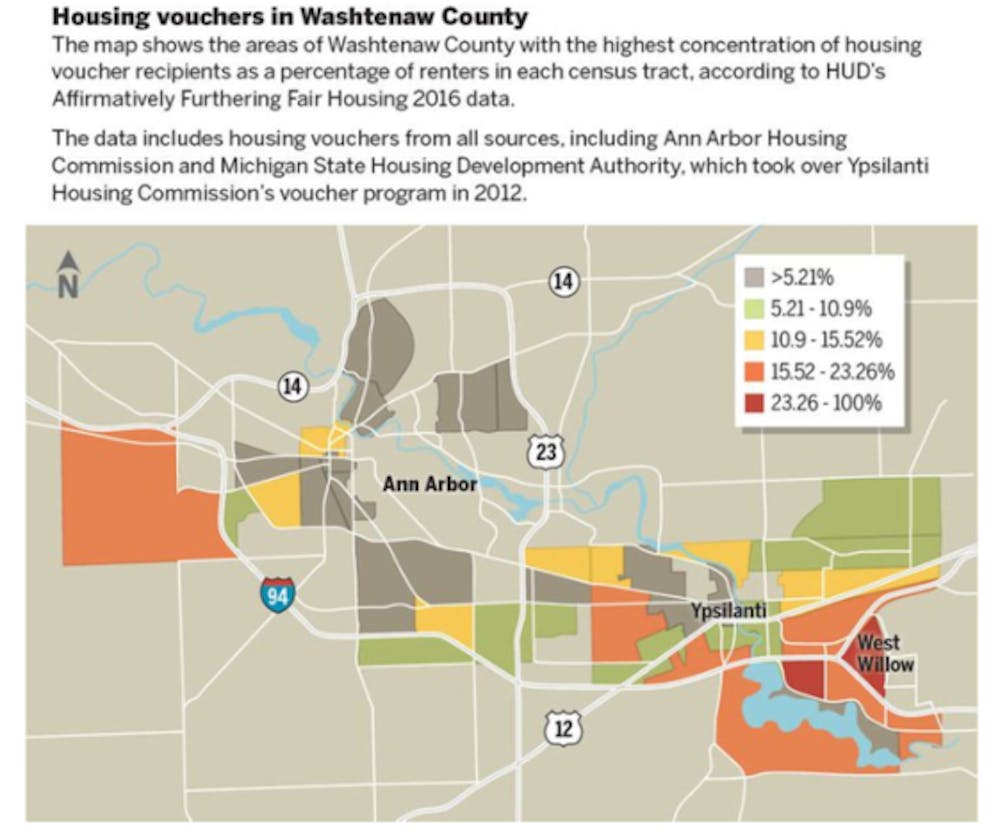Ann Arbor is often regarded as an open, tolerant and liberal city. Throughout its neighborhoods, signs stating “All are Welcome Here” and “Hate has no Home Here” are commonplace. The city prides itself on accepting people of any cultural, racial or socioeconomic background. While these ideals might be verbally supported throughout the community, they are absent when it comes to housing policy. As Ypsilanti’s rental market becomes more expensive, the future of housing within Washtenaw County will be decided by the City of Ann Arbor and its residents.
The Ann Arbor metro area is the eighth most economically segregated metro area in the entire nation. The vast majority of Washtenaw County tenants, who qualify for Section 8 Housing Vouchers, reside in Ypsilanti and Ypsilanti Township. This is due to a massive shortage of affordable housing within Ann Arbor, creating vast economic disparities throughout Washtenaw County that literally shorten peoples’ lives. There is a nine-year difference in life expectancy between Ann Arbor and Ypsilanti residents.

In 2015, the Washtenaw County government hired CZB to conduct a study on housing within the county. The findings showed a dire situation. Ann Arbor’s defacto housing policy is to push low-income individuals into the cheaper rental market of Ypsilanti, while not addressing its own deficiency of affordable rental units.
In 2000, there were 11,397 unaffordable and 3,428 very-unaffordable tenants within Washtenaw County. By 2012, both groups had more than doubled. Unaffordable tenants increased to 23,835, while very-unaffordable went up to 8,506. This is a drastic increase in the amount of unaffordable housing. In 2019, more than 4,300 individuals who qualified for Section Eight Housing Vouchers applied for the 600 spots on Ann Arbor’s affordable housing waitlist. This demand is not being met by the Ann Arbor rental market. The city has to step in.
In short, Ypsilanti has too much subsidized housing, while Ann Arbor has too little. This lack of affordable housing in Ann Arbor is making Ypsilanti more expensive as higher income residents move in for the cheaper cost of living, worsening an already bad situation.
To ensure that Washtenaw County does not become a dystopian nightmare of inequality, CZB concluded that Ann Arbor must add 2,800 affordable units by 2035. Since 2015, they have added an estimated 50, far below the 140 a year required to meet the goal.
The City of Ann Arbor and its residents have to step up to the plate and begin approving high rises in its downtown that consist of both market rate and affordable rental units. This will change the look and nature of downtown but to make Ann Arbor more affordable, the supply of rental units, both market rate and affordable, has to be increased.
Right now, there are multiple downtown high-rise apartment buildings awaiting council approval. The Ann Arbor Planning Commission voted 7-0 earlier this month to approve a 19-story high rise on State Street. This is great news but of the 240 apartments, only 19 will be affordable. This is not nearly enough, especially if the findings in the CZB report are to be taken seriously.
The main roadblock to addressing this issue will be Ann Arbor residents who are suspicious of such change. Will they be willing to see downtown become much more densely populated? Residents have rejected developments in the past. In 2018, Proposal A was approved, banning the city from selling the downtown library lot for development. The ballot proposal was a response to the city striking a deal to sell the lot to Core Spaces, which would have built a 17-story apartment building consisting of some affordable rental units.
Residents did not want this but Ann Arbor Mayor Christopher Taylor and multiple council members supported it, arguing that it would have created more affordable rental units thereby lowering rental prices by increasing the housing supply.
The future of Washtenaw County housing hinges on how many affordable units Ann Arbor will add in the coming decade. If the liberal capital of Michigan wants to prove itself, it will have to drastically increase its affordable housing or risk making an already unequal county somehow worse.









